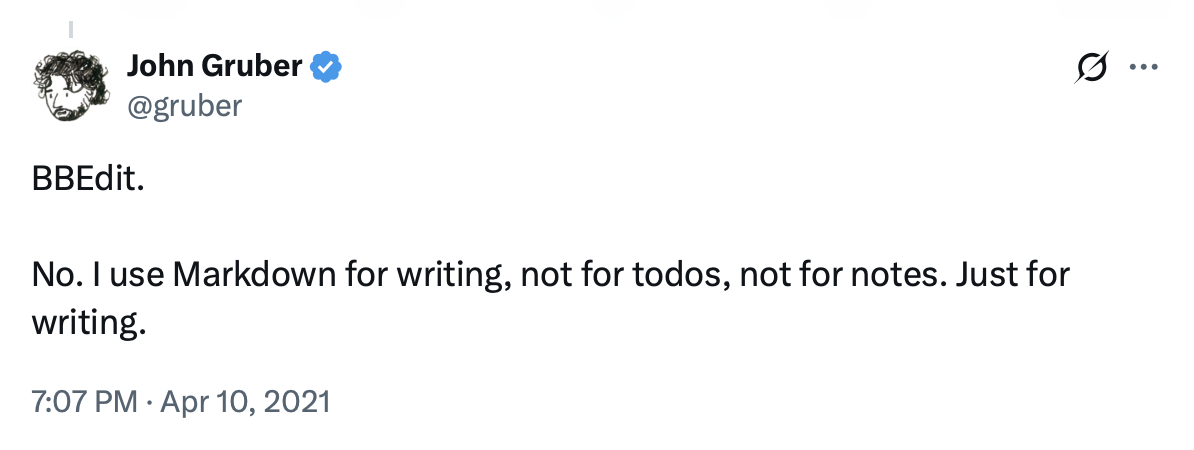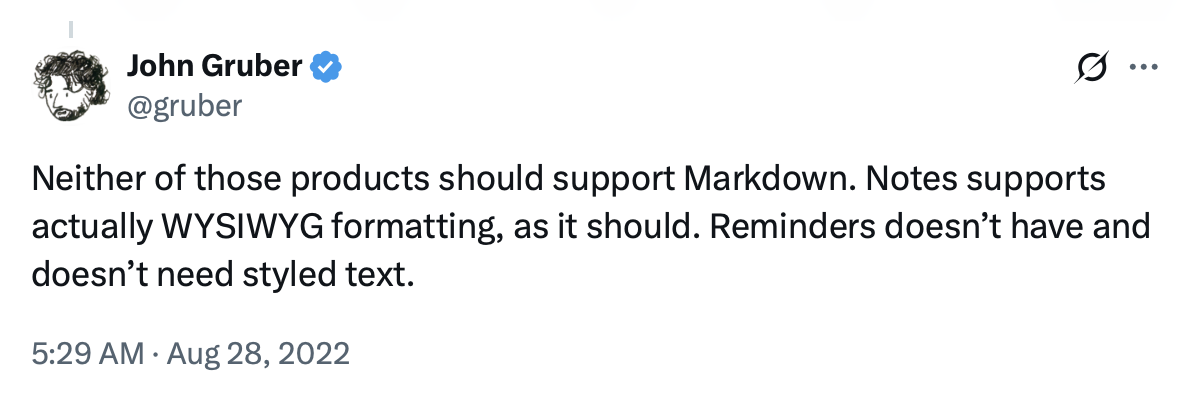Markdown is not for everything
Perhaps about two years ago I came across John Gruber’s thoughts on Markdown. These were not his musings from back when he created the markup language but years later, in 2021, when he shared his thoughts on how Markdown was being used then. Because I would rather not link to Twitter, here are screenshots:

This was his fundamental argument against the way Markdown is being used today. I am all for creators offering their opinions on their products, but I also recognise that some products—particularly successful ones—quickly bend to the will of the public and it matters little, over time, what the creators themselves think. So when I first came across this I scoffed. Why not use Markdown everywhere?

Gruber also insisted that Markdown should not be a means of storing content, simply of writing something up with the expressed intent of producing an alternate format for output. In other words, it is fine to use Markdown as I am doing it now, because these words will eventually end up as HTML on a webpage; but it was not a good idea to write notes in emacs and save them as markdown when I knew that was the end of the road for those notes.

Specifically addressing the use of Markdown in notes (especially in the Apple Notes app) Gruber insisted that Notes rightly does not support Markdown and uses WYSIWYG instead.
Although I disagreed with all three points back then, I am now of the opinion that Gruber might have been on to something. But first it is important to understand why we prefer Markdown. To put it simply, it gives us the best of both worlds: the convenience of rich text formatting with the ease and independence of plain text storage. Similarly, why does Gruber not prefer Markdown for all writing? Because it is clunky and ever so slightly unnatural to type.
However, I think the point here should go beyond Markdown as a language for writing stuff to how computer programs should handle markdown. Having written a lot of notes, particularly academic ones, with Markdown, while I like the [@citekey] format of handling citations with Zotero, I find myself hitting ⌘ I to italicise text or using other similar commands for formatting rather than keeping track of asterisks and brackets. Programs not intended for conversion to alternate formats like HTML or PDF should do a better job of keeping Markdown behind the scenes.
What we need is a notes app that looks and behaves like a rich text editor but saves in Markdown. And by this I do not mean the clunky ‘source editor mode’ or whatever Obsidian calls it, where the Markdown formatting characters appear and disappear constantly displacing the text on your screen; instead I mean proper formatting like in a word processor. For everywhere else where Markdown is used intentionally the markup should be handled openly, like iA Writer and BBEdit do already, and not be hidden away.
This seems simple enough but there is hardly an app that fills this space. Bear is an app that comes close but it manages files on its own database and not on the local machine, making it a chore to first export files before working on them on another program. What we need is a Bear and Obsidian crossover, something Bear is better-equipped but reluctant to produce at this point. And so my wait for a suitable note-taking app continues.
This is a note: a brief thought or notable piece of information from my commonplace book. For longer writings, please see ‘Essays’.